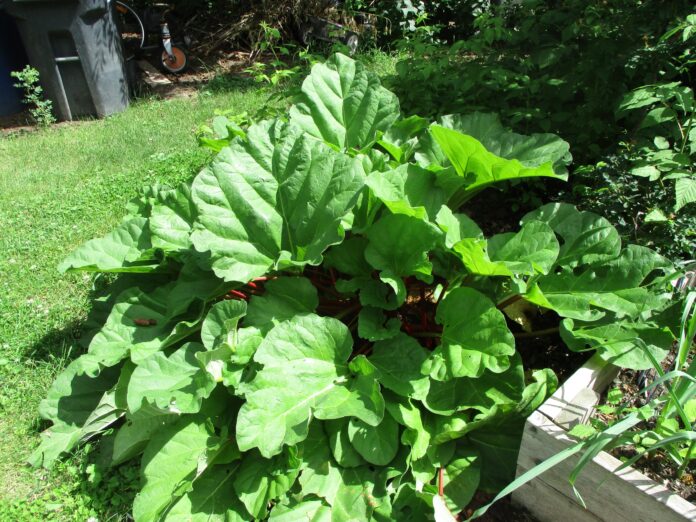by Jackie Bantle
Saskatchewan Perennial Society
When I was growing up, it seemed like rhubarb was a major staple in every garden. Rhubarb, although not botanically classified as a fruit, provided ‘fruit’ throughout the gardening season for pies, jams, cakes and crisps when fruit was not a readily available commodity like it is in today’s modern cuisine. Not as common in gardens as it was in the past, rhubarb is an easy to grow perennial vegetable that should be included in everyone’s garden.
Despite the familiarity of rhubarb on the Prairies, it did not originate here. Early European settlers brought domesticated rhubarb with them to North America. Rhubarb was one edible perennial plant that could survive the harsh northern winters. Rhubarb originated in various parts of China and Russia, growing wild in the cold climate of Mongolia, the Himalayas and Siberia. Records from 2700 BC in China indicate that the Chinese rhubarb root (Rheum palmatum) was used extensively as a laxative but also known for curing fevers, preventing the plague, reducing inflammation and healing soldiers. The earliest recorded use of rhubarb as a food plant was in 1778 when rhubarb stems were used as a filling for tarts and pies. Chinese rhubarb (also known as Turkey or Indian rhubarb) has medicinal properties and a much stronger taste than the rhubarb commonly found in the North American garden (Rheum rhaponticum). The rhubarb that we grow in our gardens today is a hybrid that was developed in the nineteenth century: the roots have little or no medicinal value.
Rhubarb grows best is full sun or light shade. Since it is a perennial vegetable, locate it along the edge of your vegetable garden where the roots will not be disturbed by tillage or digging. If multiple rhubarb plants are being planted, space plants a minimum or 1.2 m apart. Full grown rhubarb plants can be 1-1.75m wide with 2m high flower stalks. Although rhubarb seeds will germinate, resulting plant quality, taste and vigor will be quite variable. It is best to grow rhubarb from root divisions. Spring is the preferred time to plant rhubarb but planting out can happen any time during the growing season. In spring, plant roots as soon as the ground is thawed. Plants should be transplanted after danger of a hard frost (-3°C) have passed.
Rhubarb will tolerate neglect but responds well to some fertility, water and well drained soil. For each plant or root division, dig the hole at least twice the size of the plant or root. The top of the crown should be no more than 5-7 cm below the soil surface. Fill the hole with a mixture of soil and compost (or well rotted manure). Pack the soil firmly around the roots, being careful not to damage the crown. Fill the hole with the soil/compost/manure mixture until it is level with the surrounding soil. Water-in the newly planted rhubarb root or plant. Soil around newly planted rhubarb plants or roots should be kept moist but never wet: overwatering will encourage root rot. Rhubarb plants can be mulched with grass clippings or chopped leaves to control weeds and conserve moisture. Do not mulch newly planted roots until shoots have emerged. Ideally, rhubarb plants prefer 2.5 cm of water each week however, once the plant is well established, rhubarb can withstand occasional drought conditions. Rhubarb plants will benefit from an annual spring application of compost or fertilizer.
To encourage a strong, well-established plant, refrain from harvesting rhubarb petioles for at least two years after planting. In the third year after planting, rhubarb stalks should be harvested freely for only 5 weeks. Stalks that are the width of an adult finger are ready for harvest. Cut stalks at the ground level. Only the red/green petioles are edible: rhubarb leaves are poisonous. As flower stalks appear, remove flowers, especially on young plants, to encourage more leaves and healthy roots. In well- established plants, never harvest more than 50% of the stalks during one season.
Large, old rhubarb plants can sometimes lose their vigour if underground shoots become too crowded.
An older rhubarb plant with many thin, spindly shoots can be rejuvenated by dividing up the roots and crown. It is best to divide the roots in spring or late fall.
This column is provided courtesy of the Saskatchewan Perennial Society (SPS; saskperennial@hotmail.com ). Check our website saskperennial.ca) or Facebook page (facebook.com/saskperennial). All Saskatchewan Perennial Society events are on hold until further notice.
18.9 C
Prince Albert
Friday, July 26, 2024


